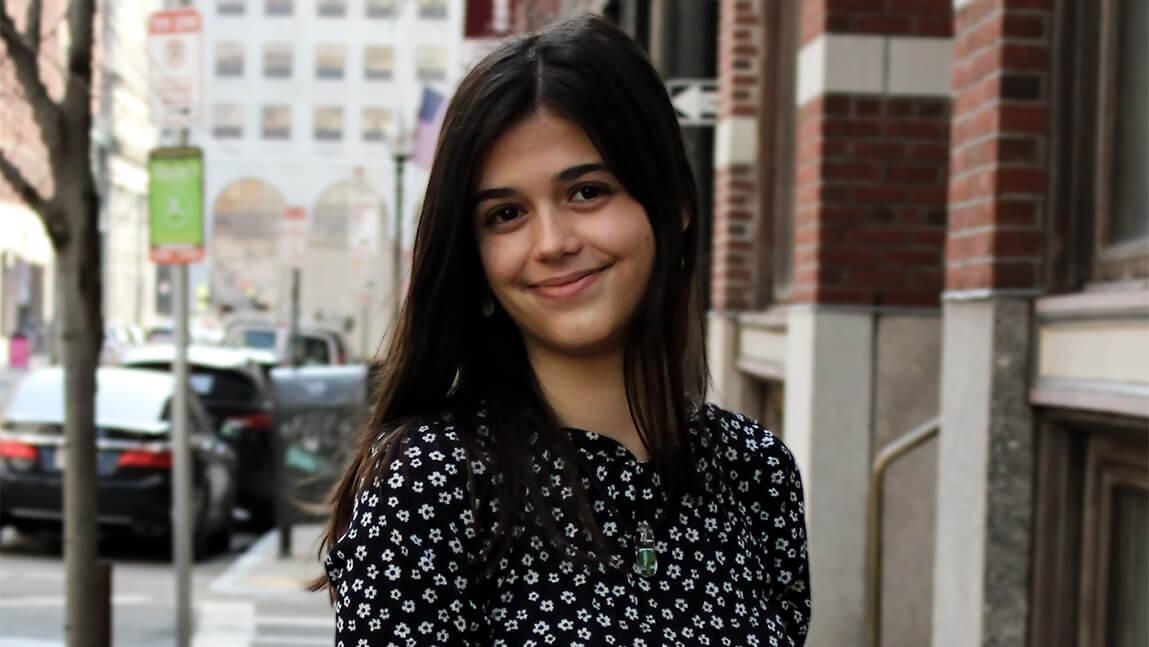Research is happening in virtually every corner of the College of Arts and Sciences. Students are asking important questions and seeking the answers in labs, yes, but also in the museum, in classrooms and lecture halls, in the library, in the theatre, in practice rooms and dorm rooms, in the forest, in the surrounding community, and even clear across the country. Not only are they making discoveries that broaden their own thinking, but these student researchers are also enriching their fields with fresh knowledge and observations, and even uncovering new possibilities for their own life paths. We asked seven of them to tell us about their experiences.
Name: Emilie Boulette (shown above)
Year: Senior
Major/minor: Sociology major, health and society minor
Research overview: “I am working as a research assistant to Professor Fothergill for the COVID-19 Immobilities Study, which includes a team of student and faculty researchers from UVM, Columbia, and the University of Ottawa. The primary focus of the research is to understand the impacts of the pandemic on three primary age demographics: children, teenagers, and older adults in the U.S. and Canada. Some of the primary indicators we're tracking among these groups are emotions experienced, challenges, coping strategies, and forms of social connectivity and resilience. My role has been primarily in data visualization, which means I take the raw numbers we’ve gathered and turn them into charts, graphs, and other data representations so they tell a story. I’ve also been working with a few U-Ottawa students on highlighting information to include in various reports from both quantitative and qualitative sources of the study.”
What has surprised her: “I was surprised to find out what a large difference there is between teen mental health in the United States and Canada. One of the key findings so far is that through the pandemic, U.S. teens experienced higher rates of poor mental health than teens in Canada did.
What she’s gained: “I've found it enriching to engage in research with students and faculty from a wide range of disciplines, as their perspectives add new meaning to the research. This experience has enabled me to develop professional skills in project management and working in a collaborative team setting, as well as helping me fine-tune more of my quantitative skills. I feel really inspired by public health and working with vulnerable populations, and I know now that I would like to go into a related field, maybe policy development.”
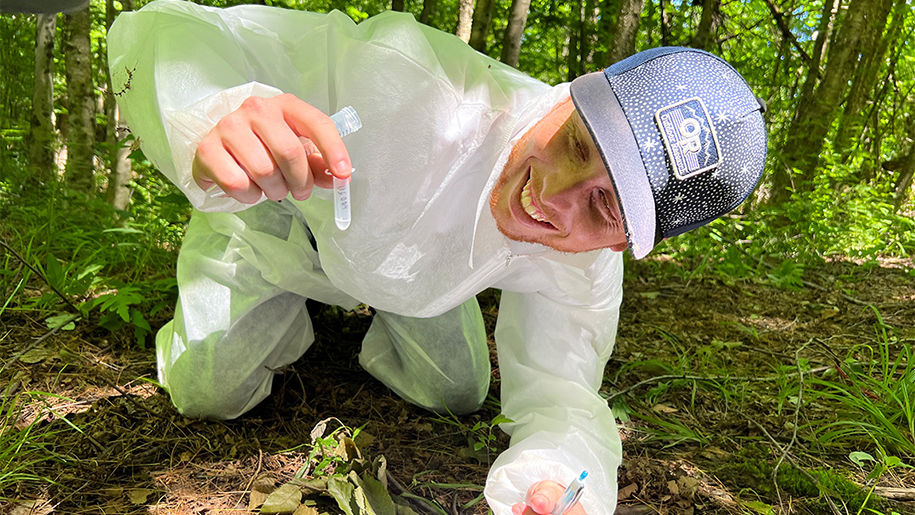
Name: Sam Cranston
Year: Senior
Major/minors: Biology major, chemistry and history minors
Research overview: “My research has focused on studying infectious diseases, such as Lyme disease, babesiosis, and anaplasmosis, that are transmitted by blacklegged or deer ticks. Blacklegged ticks pose a significant public health concern to humans, domestic animals, and wildlife, and in recent years, the populations of both the ticks and their pathogens have expanded in range and become more prevalent in the United States. I am interested in how land use changes impact the prevalence of tick-borne pathogens and also whether the co-infection rates—when a host carries more than one pathogen—are different than what we would expect to see if they were carrying just one pathogen. To examine these research questions, I collected 238 nymphal blacklegged ticks at five sites across an area in northern Vermont, then screened them for three important pathogens that can be transmitted from animals to humans. I found infection with all three pathogens in my collected ticks.” What has surprised him: “This study remains ongoing, but the preliminary data I have collected so far indicates a higher co-infection rate of the three pathogens than I had initially expected. I’ve also found multiple cases of a tick testing positive for all three diseases, which was also unexpected. According to the preliminary data, it appears that the nymphal blacklegged ticks in Vermont might be carrying these three pathogens at rates higher than what was previously believed.”
What he’s gained: “Recently, I accepted a position as a research associate at the Center for Regenerative Medicine (CReM) of Boston University and Boston Medical Center. I will be working in the Murphy Lab studying hematopoietic stem cell biology and blood disorders. The research experience I have gained from conducting my study of tick-borne pathogens likely played a pivotal role in CReM extending me the offer.”
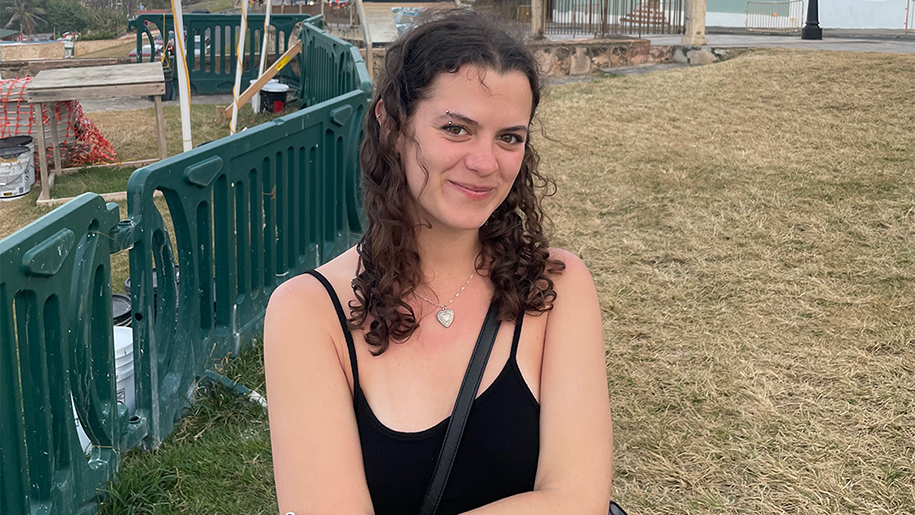
Name: Olivia Norvell
Year: Senior
Majors: Gender, Sexuality, and Women’s Studies and English
Research overview: “I did a close reading of Simone de Beauvoir’s The Second Sex and further analyses of her work in order to determine whether it implies a distinction between sex and gender. After the sex/gender distinction became popularized, theorist Judith Butler wrote “Sex and Gender In Simone de Beauvoir’s The Second Sex,” claiming that the text implied a biological understanding of sex and a psychological understanding of gender. This prompted other writers, such as Toril Moi and Sara Heinämaa, to chime in. In my research, I closely examined de Beauvoir’s book in order to determine whether or not the sex/gender distinction exists within her work and also whether any of the subsequent analyses of her work were taking her words out of context.”
What has surprised her: “Something that surprised me while doing this work was how complex it all is, despite it being a tight circle of work. I found myself changing my mind constantly about where I wanted it to go, and eventually allowed myself to not even form a solidified conclusion about what I thought. By the end, I had developed a surprising amount of appreciation for the ambiguity and nuance that comes with projects like this.”
What she’s gained: “Doing this project allowed me a lot of confidence in my academic ability! I presented my work at the gender studies conference Thinking Gender at the University of Los Angeles in February. That was a really rewarding and enriching experience, both to have my work validated in that way and also to be surrounded by people who are interested in the same subjects as I am.”
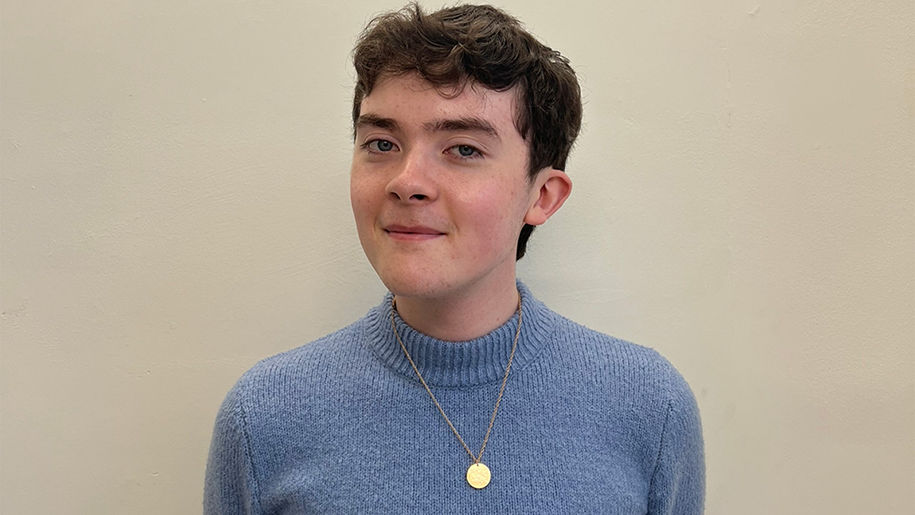
Name: Cole Barry
Year: First-year
Major/minor: English major, art history minor
Research overview: “My project brings ekphrastic poetry (poetry written about visual art) to contemporary abstract art pieces found in the Fleming Museum, with the goal of answering the following questions: Can a poem interpret a painting? Is ekphrastic poetry still relevant to contemporary visual art? What is the goal of ekphrasis as a poetic practice? During my first year at UVM, I developed a deep interest in the New York School of poets from the ‘50s and ‘60s, especially Frank O’Hara and John Ashbery. But as I explored their work, I became interested in how ekphrasis could interact with art that has emerged since the 1980s. My collection experiments with how established forms of poetry might bring form to highly abstract painting.”
What has surprised him: “While doing this project I’ve found myself sent in a different direction. I’ve begun to think that attempting to use a poem to interpret a work of art may be the wrong way to approach this, as the poem is still coming from the writer or the speaker. It feels truer to have the painting itself serve as a basis or inspiration for the writing.”
What he’s gained: “This project has helped me bridge the gap between visual art and literature. It’s led me to wonder whether poetry might be a better mode of describing what’s going on in these abstract paintings because they’re so complex. I’m looking for a publisher for the poems I’ve written so far, and I’m going to continue to write ekphrastic poetry and expand outside the Fleming Museum.”
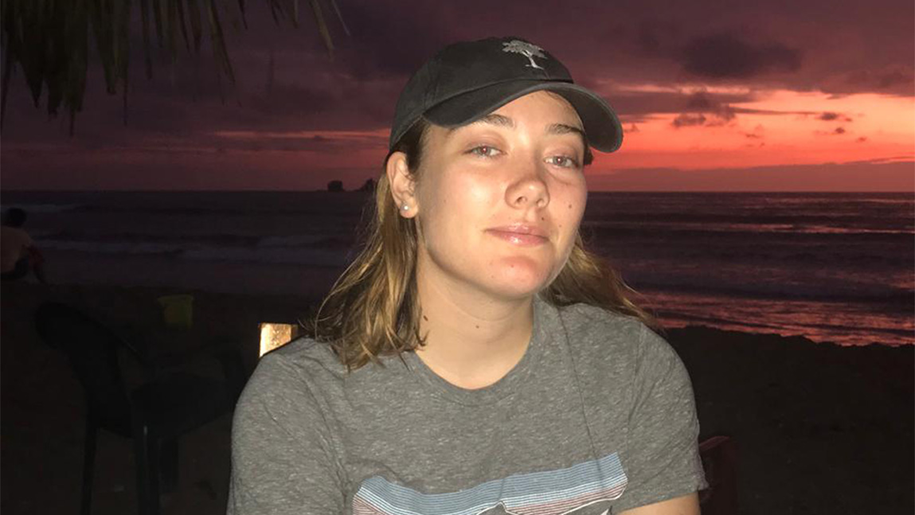
Name: Eliza Webber-Gebb
Year: Sophomore
Majors/minors: Geography, Global Studies, and Environmental Studies majors, Latin American and Caribbean Studies minor
Research overview: “I recently worked alongside Professor Pablo Bose to do a community needs assessment of the Afghan refugee community in Vermont. My role involved entering data from 60 surveys with Afghan refugees across the state, followed by helping draft and create a report with feedback and suggestions for going forward. The survey involved questions on demographic information; arrival experiences relating to education and employment; and arrival experiences relating to social services and housing. The goal of the survey and the subsequent report was to enable Afghan refugees in Vermont to reflect on the resettlement process, including what has been good and what could be better, and to think about how to best serve future refugee communities in terms of transportation, education, food, language learning, and more.”
What has intrigued her: “The most interesting aspect of the research I am doing has been learning more about the different pathways for refugee resettlement and the structure of the refugee resettlement system in the U.S., including humanitarian parole, Special Immigrant Visas, and more. It has also been invaluable to be able to collaborate with and learn more about where Afghan refugees are located across Vermont.”
What she’s gained: “As a result of this research, I hope to become more involved with local communities in Vermont. It can sometimes seem hard for college students to get involved with the local community, and I hope to change that, to be engaged with surrounding communities, and to form meaningful connections. Professionally, I have also gained invaluable research skills in areas like surveys, Excel, report creation, and more.”

Name: William Stoll
Year: Senior
Major: Biochemistry
Research overview: “My research aims to quantify and characterize the forces that exist between molecules, and we do this both experimentally (in the lab) and theoretically (on the computer). If you look at a solid like a crystal, the molecules fit together like puzzle pieces, and specific forces are present that hold the solid together. We look at two crystals with very similar molecular structures but how they fit together is different. That small structural change causes a whole new spectrum of intermolecular forces—and we aim to figure out which dictate the macroscopic properties of the crystal. This holds implications for material design, but for me, the important thing is the opportunity to advance knowledge in our scientific field.”
What has surprised him: “When I started, I thought I was going to be washing beakers, but with close help from my lab mate, Peter Banks, and Professor Ruggiero, I’ve gotten to do a lot of the research myself. I’m surprised by how much I love it. I don’t have be here more than a few hours a week but I’m here more like 20 or 25 hours. What’s mesmerizing to me is, I’m putting out a new piece of knowledge into the world.”
What he’s gained: “I’ve learned more about chemistry and what it means to be a scientist in my time with Professor Ruggiero than I have anywhere else in my life. I would never be on the path I am now without my time in the lab, and I am very thankful. I was recently selected to present at the Spring 2023 American Chemical Society National Meeting in Indianapolis and was a finalist for best presentation. This has been an amazing opportunity to work towards a collective goal of advancing the scientific field, and it is what I would like to do as a career.”
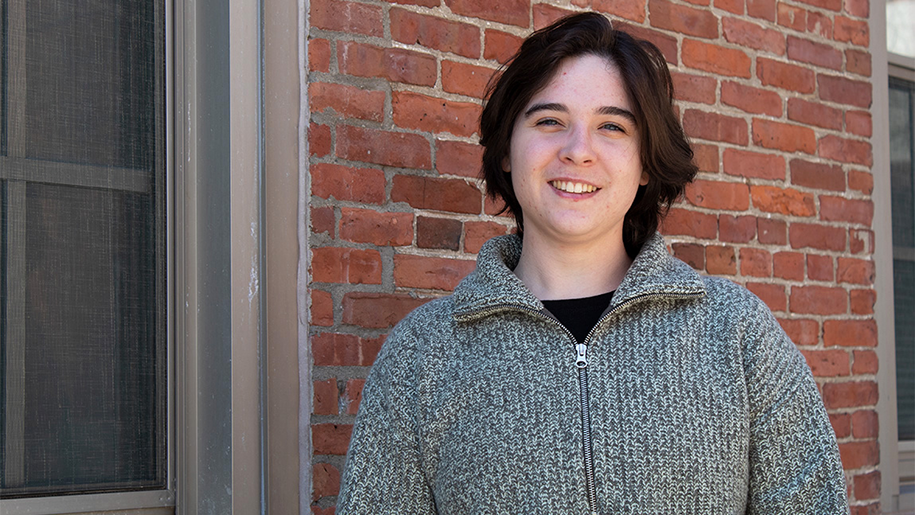
Name: Fiona Haverland
Year: Senior
Majors: Anthropology and Spanish majors
Research overview: “Pottery is an incredibly important artifact type in archaeology because it often preserves relatively well, was used by many people in daily life in the past and can take on many different appearances in terms of form and decoration. That allows archeologists to glean information about religious and cultural beliefs, trade relationships, and daily life of past communities. My thesis research focuses on a type of pottery called Fourmile Polychrome that was produced by a handful of Ancestral Pueblo villages in what is now east-central Arizona during the 14th century. I am working to understand how Fourmile Polychrome bowls may have been moved from the sites where they were produced to the sites where they were found by archaeologists. There are two hypotheses for why the pottery was moved, one based on gifting as a way to keep social relationships alive and the other based on bartering goods. In the second, the person would be carrying more pottery, so they would expend more energy and might need to take a less direct path in rugged terrain. I based my models on four different factors: slope, walking time, and the energy expenditure of these two scenarios, and am now in the process of validating them and determining whether the pathways generated by the models match known historical trails.”
What has surprised them: Something interesting that has emerged in this research is that the routes generated by the energy expenditure models are very similar to one another, implying that the economic system in which the circulation of Fourmile Polychrome took place probably didn’t affect the pathways used to move it from place to place. I’m looking forward to completing the validation of my models so that I can better interpret them.”
What they’ve gained: “I hope this research will be helpful to other scholars in the future. Fourmile Polychrome is a highly studied pottery type in that area of Arizona, but little research has been done on the trails involved in its circulation. This project has given me a chance to learn and perfect new Geographic Information Systems modeling techniques, which I hope will serve me well in my future career in archaeology.”
